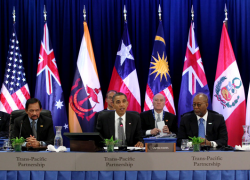
The next round of negotiations on the proposed Trans-Pacific Partnership (TPP) will be held in Singapore this month. This will be the 16th round of negotiations, and they will be held from March 4 to March 13, just seven months ahead of the self-imposed deadline for a deal. The Office of the United States Trade Representative regards the potential treaty as a comprehensive, high standard, next-generation trade agreement that would create the largest free trade area in the world. The provisions reflect an aggressive free trade policy and have drawn comparable criticism.
The United States’ participation in the TPP furthers the United States’ free trade policy strategy that began with the North American Free Trade Agreement (NAFTA) in 1994 and continued through free trade agreements (FTAs) negotiated under George W. Bush. The strategy is referred to as “competitive liberalization.” These FTAs were created contemporaneously with a number of other free trade agreements within the Asian Pacific Region. Although the United States currently has free trade agreements with several of the negotiating countries, its involvement in negotiating the TPP began in 2009, following the stall of the Doha Round.
There are currently eleven countries negotiating the TPP, including the U.S., Canada, Singapore, and Australia. The intellectual property, investment/financial services, and dispute resolution components are the most controversial. The stated purpose of the TPP is to enhance trade and investment among partner countries, promote innovation, economic growth and development, and support the creation and retention of jobs. Some commentators believe the agreement is intended to counter China’s role in regional integration and contain China’s economic rise.
The TPP has met with criticism one would expect of a large multilateral free trade proposal, exacerbated by the public’s limited access to the negotiations. Negotiations are open only to stakeholders, which predominantly consists of large corporations as well as small businesses. The potentially stringent intellectual property provisions and investment protection, which go beyond standards found in other international agreements (such as TRIPS and GATS), in particular, have been cause for concern. Some countries’ negotiators are reluctant to agree to far-reaching text proposed by the United States.
The TPP has also been subject to the standard criticisms of liberalization measures, such as the undue influence of corporate interests and the unfair exploitation of labor. The familiar complaints may be explained by the dichotomy of classical versus Keynesian economics. Classical economics holds that economic resources will flow to where they are most efficiently utilized in the long run, whereas John Maynard Keynes famously remarked, “In the long run, we are all dead.” As the global economy shifts to favor higher skilled labor and long-term, capital intensive projects, nations will realize that protecting domestic labor from foreign interests is a losing proposition and will only result in a stagnant economy akin to Venezuela’s. The world should expect more of these large free trade proposals in the near future: just this February, Secretary of State John Kerry called for a free trade agreement with Europe. Meanwhile China, Japan, and Korea have been discussing a free trade agreement of their own.
Although these free trade policies show no sign of subsiding, citizens around the world should remain vigilant in protecting issues overlooked on the international stage. Consequences from the export of subsidized commodities or the environmental impact of mining or manufacturing should continue to be vigorously exposed and publicized. Although the digital revolution has increased the pressures of globalization, it has also given average citizens the tools to unite and fight injustice.
Alex Milgroom is a University of Denver 2L and staff editor of the Denver Journal of International Law and Policy. Alex is currently studying abroad at Temple University Japan.

